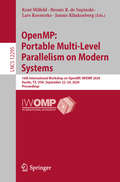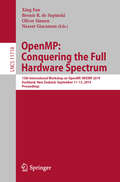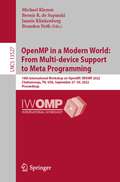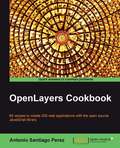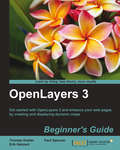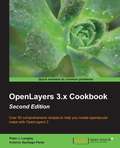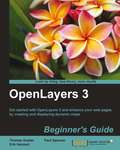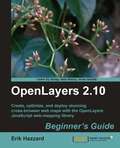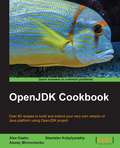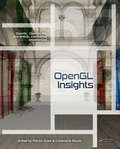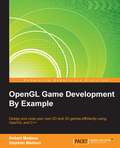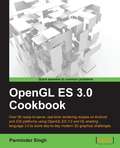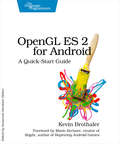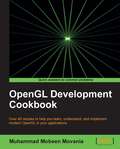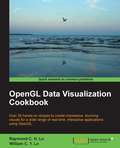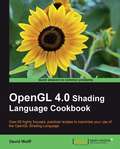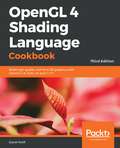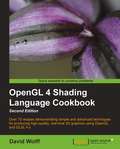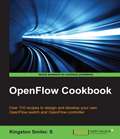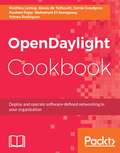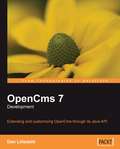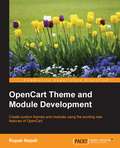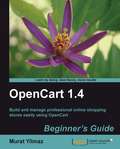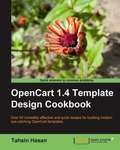- Table View
- List View
OpenMP: 16th International Workshop on OpenMP, IWOMP 2020, Austin, TX, USA, September 22–24, 2020, Proceedings (Lecture Notes in Computer Science #12295)
by Bronis R. de Supinski Kent Milfeld Lars Koesterke Jannis KlinkenbergThis book constitutes the proceedings of the 16th International Workshop on OpenMP, IWOMP 2020, held in Austin, TX, USA, in September 2020. The conference was held virtually due to the COVID-19 pandemic. The 21 full papers presented in this volume were carefully reviewed and selected for inclusion in this book. The papers are organized in topical sections named: performance methodologies; applications; OpenMP extensions; performance studies; tools; NUMA; compilation techniques; heterogeneous computing; and memory.The chapters ‘A Case Study on Addressing Complex Load Imbalance in OpenMP’ and ‘A Study of Memory Anomalies in OpenMP Applications’ are available open access under a Creative Commons Attribution 4.0 License via link.springer.com.
OpenMP: 15th International Workshop on OpenMP, IWOMP 2019, Auckland, New Zealand, September 11–13, 2019, Proceedings (Lecture Notes in Computer Science #11718)
by Bronis R. de Supinski Xing Fan Oliver Sinnen Nasser GiacamanThis book constitutes the proceedings of the 15th International Workshop on Open MP, IWOMP 2019, held in Auckland, New Zealand, in September 2019. The 22 full papers presented in this volume were carefully reviewed and selected for inclusion in this book. The papers are organized in topical sections named: best paper; tools, accelerators, compilation, extensions, tasking, and using OpenMP.
OpenMP in a Modern World: 18th International Workshop on OpenMP, IWOMP 2022, Chattanooga, TN, USA, September 27–30, 2022, Proceedings (Lecture Notes in Computer Science #13527)
by Bronis R. de Supinski Michael Klemm Jannis Klinkenberg Brandon NethThis book constitutes the proceedings of the 18th International Workshop on OpenMP, IWOMP 2022, held in Chattanooga, TN, USA, in September 2022.The 11 full papers presented in this volume were carefully reviewed and selected for inclusion in this book from the 13 submissions. The papers are organized in topical sections named: OpenMP and multiple nodes; exploring new and recent OpenMP extensions; effectie use of advanced heterogeneous node architectures; OpenMP tool support; OpenMP and multiple translation units.Chapter "Improving Tool Support for Nested Parallel Regions with Introspection Consistency" is publshed Open Access and licensed under the terms of the Creative Commons Attribution 4.0 International License (http://creativecommons.org/licenses/by/4.0/).
OpenLayers Cookbook
by Antonio Santiago PerezThis cookbook follows a problem-solution approach to doing important tasks and is packed with examples accompanied by the necessary code and screenshots. If you are a GIS-related professional with some basic knowledge of web technologies and want to start or gain in-depth knowledge of creating web mapping applications, this book is written for you. The recipes are appropriately mixed to suit JavaScript newbies or experts and cover basic to advanced topics on OpenLayers.
OpenLayers 3: Beginner's Guide
by Paul Spencer Thomas GratierWhether you are a hobbyist or a professional web developer, if you wish to use maps on your website, then this book is for you. A basic understanding of JavaScript will be helpful, but is not necessary. If you've never worked with maps before, this book will introduce you to some common mapping topics and will guide you through the OpenLayers library. Experienced developers can also use this book as a reference to OpenLayers 3 components and to further enhance their knowledge.
OpenLayers 3.x Cookbook - Second Edition
by Antonio Santiago Perez Peter J. LangleyOver 50 comprehensive recipes to help you create spectacular maps with OpenLayers 3 About This Book * Create highly customized mapping apps for the web with rich interactivity and diverse content using JavaScript * See how successful mapping apps work and how they integrate with third-party services * Packed full of code examples, screenshots, and explanations from professionals in the industry Who This Book Is For If you are a GIS-related professional with basic knowledge of web technologies and want to gain in-depth knowledge of creating web mapping applications, then this book is for you. The recipes will be appropriately mixed to suit JavaScript beginners or experts and cover basic to advanced topics on OpenLayers. What You Will Learn * Create stunning maps, and understand projection. * Add customized raster and vector layers * Work with important tile providers * Work with OGCs, WMS, and WFS compliant servers * Read/write features from/to different data sources * Style features to improve their visualization * Understand events and work with the main controls * Enhance maps with HTML5 technologies such as Geolocation In Detail Data visualization and analytics has become an important task across all technology-based industries. OpenLayers 3,is one of the most important and complete open source JavaScript mapping libraries today. Throughout this book, you will go through recipes that expose various features of OpenLayers 3, allowing you to gain an insight into building complex GIS web applications. You'll get to grips with the basics of creating a map with common functionality and quickly advance to more complicated solutions that address modern challenges. You will explore into maps, raster and vector layers and styling in-depth. This book also includes problem solving and how-to recipes for the most common and important tasks. The range of recipes includes: creating basic maps, working with raster and vector layers, understanding events,working with the main controls, reading features from different data sources, styling features, and understanding the underlying architecture. It will also cover solutions and optimizations to challenges commonly faced in modern applications. Style and approach This book teaches you how to create stunning maps that are highly interactive and visually appealing with the help of 50 handpicked recipes. Each recipe will address your need to visualize data on a map. Just follow the steps in the recipes to create maps of your choice in no time.
OpenLayers 3 Beginner's Guide
by Thomas Gratier<P><P>About This Book <P><P>Create and display maps online with the latest HTML5 features available, using the OpenLayers 3 library <P><P>Learn how to interact with the map and learn best practices to improve the loading time for a map <P><P>A practical beginner's guide, which also serves as a quick reference with useful screenshots and detailed code explanations <P><P>Who This Book Is For <P><P>Whether you are a hobbyist or a professional web developer, if you wish to use maps on your website, then this book is for you. A basic understanding of JavaScript will be helpful, but is not necessary. If you've never worked with maps before, this book will introduce you to some common mapping topics and will guide you through the OpenLayers library. Experienced developers can also use this book as a reference to OpenLayers 3 components and to further enhance their knowledge. <P><P>What You Will Learn <P><P>Build a complete, real-world OpenLayers application optimized for production use <P><P>Work with different raster data sources to create a base map <P><P>Overlay vector data sources and work with vector features directly <P><P>Customize the appearance of vector layers <P><P>Understand the concept of map projections and how to use them <P><P>Manage and work with interactions such as click and touch <P><P>Work with controls to enhance the user experience <P><P>Target mobile platforms and explore challenges presented by mobile development <P><P>In Detail <P><P>This book is a practical, hands-on guide that provides you with all the information you need to get started with mapping using the OpenLayers 3 library. <P><P>The book starts off by showing you how to create a simple map. Through the course of the book, we will review each component needed to make a map in OpenLayers 3, and you will end up with a full-fledged web map application. You will learn the key role of each OpenLayers 3 component in making a map, and important mapping principles such as projections and layers. You will create your own data files and connect to backend servers for mapping. A key part of this book will also be dedicated to building a mapping application for mobile devices and its specific components.
OpenLayers 2.10 Beginner's Guide
by Erik HazzardThis is a beginner's guide with the essential screenshots and clearly explained code, which also serves as a reference.This book is for anyone who has any interest in using maps on their website, from hobbyists to professional web developers. OpenLayers provides a powerful, but easy-to-use, pure JavaScript and HTML (no third-party plug-ins involved) toolkit to quickly make cross-browser web maps. A basic understanding of JavaScript will be helpful, but there is no prior knowledge required to use this book. If you've never worked with maps before, this book will introduce you to some common mapping topics and gently guide you through the OpenLayers library. If you're an experienced application developer, this book will also serve as a reference to the core components of OpenLayers.
OpenJDK Cookbook
by Alex Kasko Stanislav KobylyanskiyIf you are an experienced Java developer using Java 7 platform and want to get your grips on OpenJDK for Java development, this is the book for you. JDK users who wish to migrate to OpenJDK will find this book very useful.
OpenGL Insights
by Patrick Cozzi Christophe RiccioGet Real-World Insight from Experienced Professionals in the OpenGL CommunityWith OpenGL, OpenGL ES, and WebGL, real-time rendering is becoming available everywhere, from AAA games to mobile phones to web pages. Assembling contributions from experienced developers, vendors, researchers, and educators, OpenGL Insights presents real-world techniques
OpenGL Game Development By Example
by Stephen Madsen Robert MadsenDesign and code your own 2D and 3D games efficiently using OpenGL and C++ About This Book * Create 2D and 3D games completely, through a series of end-to-end game projects * Learn to render high performance 2D and 3D graphics using OpenGL * Implement a rudimentary game engine using step-by-step code Who This Book Is For If you are a prospective game developer with some experience using C++, then this book is for you. Both prospective and experienced game programmers will find nuggets of wisdom and practical advice as they learn to code two full games using OpenGL, C++, and a host of related tools. What You Will Learn * Set up your development environment in Visual Studio using OpenGL * Use 2D and 3D coordinate systems * Implement an input system to handle the mouse and the keyboard * Create a state machine to handle complex changes in the game * Load, display, and manipulate both 2D and 3D graphics * Implement collision detection and basic physics * Discover the key components needed to complete a polished game * Handle audio files and implement sound effects and music In Detail OpenGL is one of the most popular rendering SDKs used to develop games. OpenGL has been used to create everything from 3D masterpieces running on desktop computers to 2D puzzles running on mobile devices. You will learn to apply both 2D and 3D technologies to bring your game idea to life. There is a lot more to making a game than just drawing pictures and that is where this book is unique! It provides a complete tutorial on designing and coding games from the setup of the development environment to final credits screen, through the creation of a 2D and 3D game. The book starts off by showing you how to set up a development environment using Visual Studio, and create a code framework for your game. It then walks you through creation of two games-a 2D platform game called Roboracer 2D and a 3D first-person space shooter game-using OpenGL to render both 2D and 3D graphics using a 2D coordinate system. You'll create sprite classes, render sprites and animation, and navigate and control the characters. You will also learn how to implement input, use audio, and code basic collision and physics systems. From setting up the development environment to creating the final credits screen, the book will take you through the complete journey of creating a game engine that you can extend to create your own games. Style and approach An easy-to-follow guide full of code examples to illustrate every concept and help you build a 2D and 3D game from scratch, while learning the key tools that surround a typical OpenGL project.
OpenGL ES 3.0 Cookbook
by Parminder SinghIf you are new to OpenGL ES or have some experience in 3D graphics, then this book will be extremely helpful in raising your expertise level from a novice to professional. The book implements more than 90 recipes to solve everyday challenges, helping you transition from a beginner to a professional.
OpenGL ES 2 for Android: A Quick-Start Guide
by Kevin BrothalerPrinted in full color.Android is booming like never before, with millions of devices shipping every day. It's never been a better time to learn how to create your own 3D games and live wallpaper for Android. You'll find out all about shaders and the OpenGL pipeline, and discover the power of OpenGL ES 2.0, which is much more feature-rich than its predecessor. If you can program in Java and you have a creative vision that you'd like to share with the world, then this is the book for you.This book will teach you everything you need to know to create compelling graphics on Android. You'll learn the basics of OpenGL by building a simple game of air hockey, and along the way, you'll see how to initialize OpenGL and program the graphics pipeline using shaders. Each lesson builds upon the one before it, as you add colors, shading, 3D projections, touch interaction, and more.Then, you'll find out how to turn your idea into a live wallpaper that can run on the home screen. You'll learn about more advanced effects involving particles, lighting models, and the depth buffer. You'll understand what to look for when debugging your program, and what to watch out for when deploying to the market.OpenGL can be somewhat of a dark art to the uninitiated. As you read this book, you'll learn each new concept from first principles. You won't just learn about a feature; you'll also understand how it works, and why it works the way it does. Everything you learn is forward-compatible with the just-released OpenGL ES 3, and you can even apply these techniques to other platforms, such as iOS or HTML5 WebGL.
OpenGL Development Cookbook
by Muhammad Mobeen MovaniaThis hands-on Cookbook cuts through the preamble and gets straight to the point. OpenGL Development Cookbook is perfect for intermediate C++ programmers. Full of practical techniques for implementing amazing computer graphics and visualizations, using OpenGL. Crammed full of useful recipes, OpenGL Development Cookbook will help you exploit OpenGL to its full potential. OpenGL Development Cookbook is geared toward intermediate OpenGL programmers to take you to the next level and create amazing OpenGL graphics in your applications.
OpenGL Data Visualization Cookbook
by Raymond C. H. Lo William C. Y. LoOver 40 hands-on recipes to create impressive, stunning visuals for a wide range of real-time, interactive applications using OpenGL About This Book * Get acquainted with a set of fundamental OpenGL primitives and concepts that enable users to create stunning visuals of arbitrarily complex 2D and 3D datasets for many common applications * Explore interactive, real-time visualization of large 2D and 3D datasets or models, including the use of more advanced techniques such as stereoscopic 3D rendering. * Create stunning visuals on the latest platforms including mobile phones and state-of-the-art wearable computing devices Who This Book Is For This book is aimed at anyone interested in creating impressive data visualization tools using modern graphics hardware. Whether you are a developer, engineer, or scientist, if you are interested in exploring the power of OpenGL for data visualization, this book is for you. While familiarity with C/C++ is recommended, no previous experience with OpenGL is assumed. What You Will Learn * Install, compile, and integrate the OpenGL pipeline into your own project * Create interactive applications using GLFW and handle user inputs with callback functions * Use OpenGL primitives and features in the OpenGL Shading Language (GLSL) * Render complex 3D volumetric data with techniques such as data slicers and multiple viewpoint projection * Implement a hardware-accelerated data visualizer, heat map generator, point cloud rendering, perspective rendering, and alpha blending * Process images or video sources with texture mapping and custom fragment shader programs for image resizing and wrapping * Develop video see-through augmented reality applications with OpenGL * Visualize 3D models using meshes and surfaces with dynamic lighting In Detail OpenGL is a great multi-platform, cross-language, and hardware-accelerated graphics interface for visualizing large 2D and 3D datasets. Data visualization has become increasingly challenging using conventional approaches as datasets become larger and larger, especially with the Big Data evolution. From a mobile device to a sophisticated high-performance computing cluster, OpenGL libraries provide developers with an easy-to-use interface to create stunning visuals in 3D in real time for a wide range of interactive applications. This book provides easy-to-follow, hands-on tutorials to create appealing OpenGL-based visualization tools with minimal development time. We will first illustrate how to quickly set up the development environment in Windows, Mac, and Linux. Next, we will demonstrate how to visualize data for a wide range of applications using OpenGL, starting from simple 2D datasets to increasingly complex 3D datasets with more advanced techniques. Each chapter addresses different visualization problems encountered in real life and introduces the relevant OpenGL features and libraries in a modular fashion. By the end of this book, you will be equipped with the essential skills to develop a wide range of impressive OpenGL-based applications for your unique data visualization needs, on platforms ranging from conventional computers to the latest mobile/wearable devices. Style and approach This is an easy-to-follow, comprehensive Cookbook showing readers how to create an application with real-time, interactive data visualization in stereoscopic 3D. Each topic is explained in a step-by-step format. A range of hot topics is included, including data visualization on mobile and wearable platforms."
OpenGL 4.0 Shading Language Cookbook
by David WolffThis hands-on guide cuts short the preamble and gets straight to the point - actually creating graphics, instead of just theoretical learning. Each recipe is specifically tailored to satisfy your appetite for producing real-time 3-D graphics using GLSL 4.0.If you are an OpenGL programmer looking to use the modern features of GLSL 4.0 to create real-time, three-dimensional graphics, then this book is for you. Familiarity with OpenGL programming, along with the typical 3D coordinate systems, projections, and transformations is assumed. It can also be useful for experienced GLSL programmers who are looking to implement the techniques that are presented here.
OpenGL 4 Shading Language Cookbook: Build high-quality, real-time 3D graphics with OpenGL 4.6, GLSL 4.6 and C++17, 3rd Edition
by David WolffOver 70 recipes that cover advanced techniques for 3D programming such as lighting, shading, textures, particle systems, and image processing with OpenGL 4.6Key FeaturesExplore techniques for implementing shadows using shadow maps and shadow volumesLearn to use GLSL features such as compute, geometry, and tessellation shadersUse GLSL to create a wide variety of modern, realistic visual effectsBook DescriptionOpenGL 4 Shading Language Cookbook, Third Edition provides easy-to-follow recipes that first walk you through the theory and background behind each technique, and then proceed to showcase and explain the GLSL and OpenGL code needed to implement them. The book begins by familiarizing you with beginner-level topics such as compiling and linking shader programs, saving and loading shader binaries (including SPIR-V), and using an OpenGL function loader library. We then proceed to cover basic lighting and shading effects. After that, you'll learn to use textures, produce shadows, and use geometry and tessellation shaders. Topics such as particle systems, screen-space ambient occlusion, deferred rendering, depth-based tessellation, and physically based rendering will help you tackle advanced topics. OpenGL 4 Shading Language Cookbook, Third Edition also covers advanced topics such as shadow techniques (including the two of the most common techniques: shadow maps and shadow volumes). You will learn how to use noise in shaders and how to use compute shaders.The book provides examples of modern shading techniques that can be used as a starting point for programmers to expand upon to produce modern, interactive, 3D computer-graphics applications.What you will learnCompile, debug, and communicate with shader programsUse compute shaders for physics, animation, and general computingLearn about features such as shader storage buffer objects and image load/storeUtilize noise in shaders and learn how to use shaders in animationsUse textures for various effects including cube maps for reflection or refractionUnderstand physically based reflection models and the SPIR-V Shader binaryLearn how to create shadows using shadow maps or shadow volumesCreate particle systems that simulate smoke, fire, and other effectsWho this book is forIf you are a graphics programmer looking to learn the GLSL shading language, this book is for you. A basic understanding of 3D graphics and programming experience with C++ are required.
OpenGL 4 Shading Language Cookbook - Second Edition
by David WolffOpenGL Shading Language 4 Cookbook is a hands-on guide that gets straight to the point - actually creating graphics, instead of just theoretical learning. Each recipe is specifically tailored to satisfy your appetite for producing real-time 3-D graphics using the latest GLSL specification.This book is for OpenGL programmers looking to use the modern features of GLSL 4 to create real-time, three-dimensional graphics. Familiarity with OpenGL programming, along with the typical 3D coordinate systems, projections, and transformations is assumed. It can also be useful for experienced GLSL programmers who are looking to implement the techniques that are presented here.
OpenFlow Cookbook
by Kingston Smiler. SThis book is intended for network protocol developers, SDN controller application developers, and academics who would like to understand and develop their own OpenFlow switch or OpenFlow controller in any programming language. With basic understanding of OpenFlow and its components, you will be able to follow the recipes in this book.
OpenDaylight Cookbook
by Jamie Goodyear Alexis De Talhouet Mathieu Lemay Mohamed El-Serngawy Rashmi PujarOver 90 recipes to gain the critical skills needed to deploy and manage OpenDaylight-based solutions About This Book • This book will help you to build intelligent SDN networks that save your company time, money, and resources • From eminent authors, learn to address real-world challenges and troubleshoot day-to-day scalability and performance problems faced in OpenDayLight deployments • This is the only book that offers you quick fixes to create your own branded OpenDaylight Who This Book Is For This book is for experienced network administrators and IT professionals who are using or deploying SDN/OpenDaylight and are looking to gain expertise in building SDN solutions for organizations. What You Will Learn • Grasp the fundamentals of OpenDaylight • Customize, authenticate, & authorize in OpenDaylight • Analyse network access control and policy • Manage datacenter optimization • Integrate OpenDaylight with third-party frameworks • Deploy, configure, and tune OpenDaylight-based solutions In Detail OpenDaylight is an open source platform to program and build Software-Defined Networks (SDN). Its aim is to accelerate the adoption of SDN and NFV. With above 90 practical recipes, this book will help you to solve day-to-day problems and maintenance tasks surrounding OpenDaylight's implementation. This book starts with the OpenDaylight fundamentals. In this book, you will gain a sound understanding of the methods and techniques when deploying OpenDaylight in production environment. Later on, you will learn to create a Service Chain using SFC. This book will address common problems and day-to-day maintenance tasks with OpenDaylight. We'll also will teach you how to interact with OpenDaylight APIs and use the necessary tools to simulate networks. You will also explore how to create your own branded OpenDaylight along with authorising and authenticating users using OpenDaylight Identity Manager. By the end of this book, you will have the necessary skills to operate an OpenDaylight SDN environment. Style and approach With a diverse range of topics, this will be a guide which will help the readers gain the necessary skills needed to deploy and operate OpenDaylight in your organisation through practical recipes.
OpenCms 7 Development
by Dan LiliedahlThis book is a clear, practical tutorial to OpenCms development. It will take you through the development of an example site, illustrating the key concepts of OpenCms development with examples at every stage. The book is for Java developers with a basic knowledge of the operations of OpenCms. No previous experience of developing OpenCms is expected.
OpenCart Theme and Module Development
by Rupak NepaliThis book is aimed at developers and designers who want to start developing their own themes and extensions and for those who want to know about the code workflow of the OpenCart theme and modules.
OpenCart 1.4: Beginner's Guide
by Murat YilmazThis is a tutorial-style book that follows a practical approach to demonstrate the potential of OpenCart. The book is suitable for those who have basic computer skills. Written with a fast-paced but friendly and engaging approach, this Packt Beginner's Guide is designed to be placed alongside the computer as your guide and mentor. Step-by-step tutorials are complemented with explanations of the reasoning behind what you are doing. You will quickly pick up the necessary skills, tips and tricks for building a successful OpenCart online store with practical examples that helps you to learn by experiment and play. This book is aimed at individuals who want to develop professional online stores without any hands-on programming experience, and clients/non-developers who will be managing their inventory and processing orders through the backend.
OpenCart 1.4 Template Design Cookbook
by Tahsin HasanThis hands-on guide cuts short the preamble and gets straight to the point with practical recipes instead of just theoretical learning. Each recipe is specifically tailored to fulfill your appetite for creating professional visually stunning templates and themes for your OpenCart store.You may be the owner of an OpenCart web store or a designer working with OpenCart. If you want to customize OpenCart to unleash its enormous potential and elevate your store to the next level, this book is for you. You must have some experience with OpenCart and understand its basic features. You also need to know HTML and should be comfortable taking up some challenges in PHP and JavaScript programming.
OpenCV: Computer Vision Projects with Python
by Joseph Howse Prateek Joshi Michael BeyelerGet savvy with OpenCV and actualize cool computer vision applications About This Book * Use OpenCV's Python bindings to capture video, manipulate images, and track objects * Learn about the different functions of OpenCV and their actual implementations. * Develop a series of intermediate to advanced projects using OpenCV and Python Who This Book Is For This learning path is for someone who has a working knowledge of Python and wants to try out OpenCV. This Learning Path will take you from a beginner to an expert in computer vision applications using OpenCV. OpenCV's application are humongous and this Learning Path is the best resource to get yourself acquainted thoroughly with OpenCV. What You Will Learn * Install OpenCV and related software such as Python, NumPy, SciPy, OpenNI, and SensorKinect - all on Windows, Mac or Ubuntu * Apply "curves" and other color transformations to simulate the look of old photos, movies, or video games * Apply geometric transformations to images, perform image filtering, and convert an image into a cartoon-like image * Recognize hand gestures in real time and perform hand-shape analysis based on the output of a Microsoft Kinect sensor * Reconstruct a 3D real-world scene from 2D camera motion and common camera reprojection techniques * Detect and recognize street signs using a cascade classifier and support vector machines (SVMs) * Identify emotional expressions in human faces using convolutional neural networks (CNNs) and SVMs * Strengthen your OpenCV2 skills and learn how to use new OpenCV3 features In Detail OpenCV is a state-of-art computer vision library that allows a great variety of image and video processing operations. OpenCV for Python enables us to run computer vision algorithms in real time. This learning path proposes to teach the following topics. First, we will learn how to get started with OpenCV and OpenCV3's Python API, and develop a computer vision application that tracks body parts. Then, we will build amazing intermediate-level computer vision applications such as making an object disappear from an image, identifying different shapes, reconstructing a 3D map from images , and building an augmented reality application, Finally, we'll move to more advanced projects such as hand gesture recognition, tracking visually salient objects, as well as recognizing traffic signs and emotions on faces using support vector machines and multi-layer perceptrons respectively. This Learning Path combines some of the best that Packt has to offer in one complete, curated package. It includes content from the following Packt products: * OpenCV Computer Vision with Python by Joseph Howse * OpenCV with Python By Example by Prateek Joshi * OpenCV with Python Blueprints by Michael Beyeler Style and approach This course aims to create a smooth learning path that will teach you how to get started with will learn how to get started with OpenCV and OpenCV 3's Python API, and develop superb computer vision applications. Through this comprehensive course, you'll learn to create computer vision applications from scratch to finish and more!.
